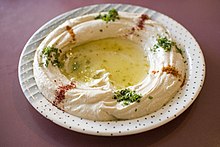Hummus: Difference between revisions
m →Nutritional information: wikilink pulses |
answers.com is not an acceptable source |
||
| Line 9: | Line 9: | ||
The origins of hummus are unknown. It is one of the oldest known prepared foods and has been used in [[Middle Eastern cuisine|Middle Eastern]] and [[Mediterranean cuisine]] for thousands of years.<ref name="mideastfood">mideastfood.about.com, ''[http://mideastfood.about.com/od/middleeasternfood101/a/hummus101.htm Hummus 101]'', retrieved 28 February 2008</ref> [[Plato]] and [[Socrates]] both noted the nourishing benefits of hummus (''hommos'' in Greek), which has been a part of Greek culture at least since classical times.<ref name="eddybles"/><ref name="mideastfood"/> An [[Ancient Egypt|ancient Egyptian]] recipe calls for [[vinegar|wine vinegar]] instead of [[lemon juice]], which did not arrive in the Middle East until about the 8th century CE.<ref>ancientnile.co.uk, ''[http://www.ancientnile.co.uk/recipes.php Ancient Niles Ancient Egyptian Recipes]'', retrieved 28 February 2008</ref> |
The origins of hummus are unknown. It is one of the oldest known prepared foods and has been used in [[Middle Eastern cuisine|Middle Eastern]] and [[Mediterranean cuisine]] for thousands of years.<ref name="mideastfood">mideastfood.about.com, ''[http://mideastfood.about.com/od/middleeasternfood101/a/hummus101.htm Hummus 101]'', retrieved 28 February 2008</ref> [[Plato]] and [[Socrates]] both noted the nourishing benefits of hummus (''hommos'' in Greek), which has been a part of Greek culture at least since classical times.<ref name="eddybles"/><ref name="mideastfood"/> An [[Ancient Egypt|ancient Egyptian]] recipe calls for [[vinegar|wine vinegar]] instead of [[lemon juice]], which did not arrive in the Middle East until about the 8th century CE.<ref>ancientnile.co.uk, ''[http://www.ancientnile.co.uk/recipes.php Ancient Niles Ancient Egyptian Recipes]'', retrieved 28 February 2008</ref> |
||
Hummus has long been a staple food in [[Syria]] and [[Lebanon]]. The dish later became popular in [[Jordan]] and [[Israel]] and has become increasingly available in [[America]] and [[Europe]]. |
Hummus has long been a staple food in [[Syria]] and [[Lebanon]]. The dish later became popular in [[Jordan]] and [[Israel]] and has become increasingly available in [[America]] and [[Europe]]. |
||
==Serving methods== |
==Serving methods== |
||
{{refimprovesect}} |
{{refimprovesect}} |
||
Revision as of 20:13, 1 March 2008
- For the biological matter in soil, see Humus; for the band, see Humus (band).

Hummus (also variously spelled hamos, houmous, hommos, hommus, hummos, hummous or humus) is a dip or spread which in modern recipes is made from blended chickpeas, sesame tahini, lemon juice and garlic. Hummus has been a dietary staple in various local forms throughout the Middle Eastern world for thousands of years.[1]
The name comes from the Arabic word for chickpeas حُمُّص (pronounced hummus). The full name in Arabic is حُمُّص بالطحينة (hummus bi tahina) which means chickpeas with tahini.
History
The origins of hummus are unknown. It is one of the oldest known prepared foods and has been used in Middle Eastern and Mediterranean cuisine for thousands of years.[2] Plato and Socrates both noted the nourishing benefits of hummus (hommos in Greek), which has been a part of Greek culture at least since classical times.[1][2] An ancient Egyptian recipe calls for wine vinegar instead of lemon juice, which did not arrive in the Middle East until about the 8th century CE.[3]
Hummus has long been a staple food in Syria and Lebanon. The dish later became popular in Jordan and Israel and has become increasingly available in America and Europe.
Serving methods
This section needs additional citations for verification. |

As an appetizer and dip hummus is scooped with flatbread (such as pita). Outside the Middle East it may be eaten with tortilla chips and crackers of various kinds. Hummus is also used as part of a meze, as a sandwich filling and as a dressing for dishes such as falafel, grilled chicken, fish or eggplant). It may be garnished chopped or thinly-sliced tomato, cucumber, cilantro, sautéed mushrooms, whole chickpeas, olive oil and hard-boiled egg.
Hummus Ful (pronounced /fuːl/) is topped with a paste made from fava beans boiled until soft and then crushed into a mush. Hummus Masubha/Mashawsha is a mixture of hummus paste, warm chickpeas and tahini.
Lebanon
In Lebanon hummus may be garnished with colorful vegetables along with parsley and sumac. Pickled turnips along with pickled cucumbers and hot green peppers may be served on the side with a traditional garnish of sour pomegranate seeds.
Hummus Awarma is topped with minced meat, onions and pine nuts.
Palestine

In Palestine pine nuts are a very traditional garnish.[4]
Egypt
Hummus is traditionally garnished with cumin in Egypt.
Jordan
In Jordan Hummus mahluta (also known as Kudshiya) is covered with a combination of ful paste and warm chick peas.
Nutritional information
Hummus is high in iron and vitamin C. The chickpeas make it a good source of protein and dietary fiber. Depending on the recipe hummus carries varying amounts of monounsaturated fat.[5] Hummus is useful in vegetarian and vegan diets and like other combinations of grains and pulses, when eaten with bread it provides most of the essential amino acids for humans.
References
- ^ a b eddybles.com, Feta Artichoke Hummus, retrieved 28 February 2008
- ^ a b mideastfood.about.com, Hummus 101, retrieved 28 February 2008
- ^ ancientnile.co.uk, Ancient Niles Ancient Egyptian Recipes, retrieved 28 February 2008
- ^ Palestinian Hummus, in the San Francisco Chronicle, Food Section, April 4 2007
- ^ Hummus NutritionData.com
